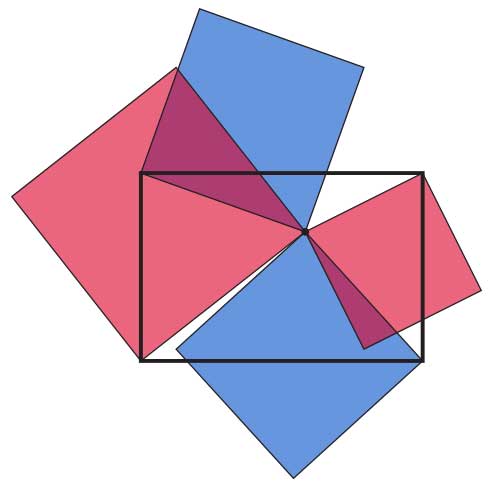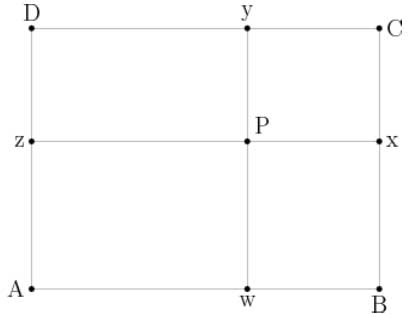.
British flag theorem
In Euclidean geometry, the British flag theorem says that if a point P is chosen inside rectangle ABCD then the sum of the squared Euclidean distances from P to two opposite corners of the rectangle equals the sum to the other two opposite corners.[1][2][3] As an equation:
\( AP^{2}+PC^{2}=BP^{2}+DP^{2}.\, \)
The theorem also applies to points outside the rectangle, and more generally to the distances from a point in Euclidean space to the corners of a rectangle embedded into the space.[4] Even more generally, if the sums of squared distances from a point P to the two pairs of opposite corners of a parallelogram are compared, the two sums will not in general be equal, but the difference of the two sums will depend only on the shape of the parallelogram and not on the choice of P.[5]

According to the British flag theorem, the red squares have the same total area as the blue squares
Proof

Illustration for proof
Drop perpendicular lines from the point P to the sides of the rectangle, meeting sides AB, BC, CD, and AD in points w, x, y and z respectively, as shown in the figure; these four points wxyz form the vertices of an orthodiagonal quadrilateral. By applying the Pythagorean theorem to the right triangle AwP, and observing that wP = Az, it follows that
\( AP^{2} = Aw^{2} + wP^{2} = Aw^{2} + Az^{2} \)
and by a similar argument the squared lengths of the distances from P to the other three corners can be calculated as
\( PC^{2} = wB^{2} + zD^{2} \),
\( BP^{2} = wB^{2} + Az^{2} \), and
\( PD^{2} = zD^{2} + Aw^{2} \).
Therefore:
\( AP^{2} + PC^{2} = (Aw^{2} + Az^{2}) + (wB^{2} + zD^{2}) = (wB^{2} + Az^{2}) + (zD^{2} + Aw^{2}) = BP^{2} + PD^{2}\, \)
Naming
The flag of the United Kingdom, also known as a "Union Jack".
This theorem takes its name from the fact that, when the line segments from P to the corners of the rectangle are drawn, together with the perpendicular lines used in the proof, the completed figure somewhat resembles a Union Flag.
References
^ Lardner, Dionysius (1848), The First Six Books of the Elements of Euclid, H.G. Bohn, p. 87. Lardner includes this theorem in what he calls "the most useful and remarkable theorems which may be inferred" from the results in Book II of Euclid's Elements.
^ Young, John Wesley; Morgan, Frank Millett (1917), Elementary Mathematical Analysis, The Macmillan company, p. 304.
^ Bôcher, Maxime (1915), Plane Analytic Geometry: with introductory chapters on the differential calculus, H. Holt and Company, p. 17.
^ Harvard-MIT Mathematics Tournament solutions, Problem 28.
^ Hadamard, Jacques (2008), Lessons in Geometry: Plane geometry, American Mathematical Society, p. 136, ISBN 9780821843673.
Undergraduate Texts in Mathematics
Graduate Studies in Mathematics
Retrieved from "http://en.wikipedia.org/"
All text is available under the terms of the GNU Free Documentation License

